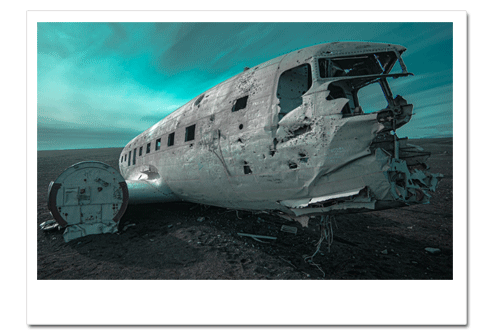
Root Cause Analysis (RCA) in Aviation
We do not see our hand in what happens, and so we call certain events melancholy accidents…
― Stanley Cavell
Another milestone in your Journey to achieve safety compliance
Simple step-by-step approach.
The Root Cause Analysis (RCA) in aviation accidents is a process that identifies the reasons for an aircraft accident. The aviation industry is constantly evolving, and so are the methods we use to analyze accidents. In recent years, accident analysis has become increasingly reliant on data from past accidents. As a result, this database can help identify common errors and causes of aviation accidents.
Understanding RCA in aviation accidents starts with identifying the steps that led to the accident. Backward reasoning method determines the causes of accidents. This means that investigators first look for reasons that may have led to the accident. After that, they work their way backward to find the step that caused the problem.
Additionally, RCA is a very important maturity indicator for implementing Safety Management System (SMS).
Backward reasoning.
The principle behind backward reasoning is to look for the cause that led to the accident. Then, work backward to find the step that caused the problem. In other words, this involves using a traceability matrix. You can implement this by asking questions such as, “What happened?”, ” Who was affected?”, and “What were the circumstances?”
Benefits of Root Cause Analysis In Aviation Accidents

The purpose of a RCA is to identify and correct the root cause of a problem in order to prevent future occurrences. Corrective action is the process of taking the necessary steps to correct the root cause of a problem. RCA is a valuable tool that can help aviation organizations prevent future occurrences.
We also use the Effective Problem-Solving Methodology to conduct a RCA. Effective problem-solving is the process of solving problems logically and effectively.
The time required to complete the RCA in aviation accidents can be elaborate, as it is important to identify all of the factors that led to the accident.
Outcomes of a Root Cause Analysis
The outcomes of a RCA can be unpredictable, but some common outcomes include preventing future accidents, correcting errors, and improving safety.
By conducting a root-cause analysis and risk mitigation techniques, such as improved safety procedures and better systems, we can greatly reduce accidents.
Also, hindsight is a valuable tool in RCA, as it can help identify factors that were not previously known. Diagrams such as a Venn diagram illustrate the relationships between the various factors that may have led to the accident.
RCA can further identify and categorize the factors that may have led to the accident.
Aviation accidents and human factors analysis.

Aviation accidents are often the result of a number of causes and contributing factors, many of which have a human dimension to them. In some cases, human error is a factor in as high as 70% of aircraft accidents. Hence, the challenge for accident investigators is how best to identify and mitigate the causal sequence of events leading up to an accident.
Human Factors Analysis and Classification System (HFACS) is a general framework for human error originally developed and tested within the USA military. This framework has been extended and adapted to analyse the underlying human factors causes in accidents involving aircraft and aviation maintenance and operations. HFACS framework provides safety professionals with a theoretical tool for identifying and classifying human errors in aviation mishaps.
The (HFACS) system focuses on both latent and active failures and their interrelationships, thereby facilitating the identification of the underlying causes of human error.
Profound root cause analysis approaches.
The most common approach is the five whys, which asks why five times. Other approaches include the Pareto principle and the fishbone diagram.
Root-cause analysis by using Bowtie analysis
Root-cause analysis focuses on identifying the root cause of the accident in a visual way.
The root main event markers are events or circumstances that associates with an accident. On the other hand, risk controls are measures that reduce the risk of an accident.
The Bowtie diagram shows the relationships among sources of hazards, risks, controls, escalation factors, events, and impacts. In addition to centralizing risk management activities for planning, coordination, and monitoring, a major benefit of the Bowtie tool is the visual depiction that emerges from the Bowtie framework of a relationship between causes, events, impacts, and controls for a hazard.
Tips For Root Cause Analysis In Aviation Accidents
We have many techniques for root-cause analysis and corrective action.
Firstly, creating a road map to show how the process works and conducting interviews with employees to find out why incidents occur.
Secondly, conduct a “Design” problem analysis by looking for ways to simplify the SOPs and identifying any steps that are redundant that we can eliminate in order to decrease the workload.
Thirdly, tailor corrective actions to ensure their effectiveness, you should tailor them to the specific problem and its urgency.
Fourth, effective management controls and recommendations must be in place to prevent the problem from occurring in the future.
Fifth, assess the consequent risks to determine how to mitigate them.
Sixth, emergency preparedness and response plan must be ready to minimize the impact of a problem if it does occur.
Seventh, develop a risk matrix and use analysis tools to identify the specific root causes of the problem.
Eighth, you can find more details about risk management and RCA resources discussing the Four Pillars of SMS.
Finally, find out how can AVISAV QSMS Software help you identify the specific actions that will mitigate risks… Contact our team for a FREE Demo.
Avisav Aviation Services Ltd.
- Expert EASA Parts 145 and 21 SMS Consulting
- Insider Hacks for Aeronautical Decision Making
- Simple Tips For Root Cause Analysis In Aviation Accidents
- Aviation Quality Management System (QMS)
- Safety (SMS) Trainer Course
Suggested for you: Read about the imporance of the smooth safety reporting system.
